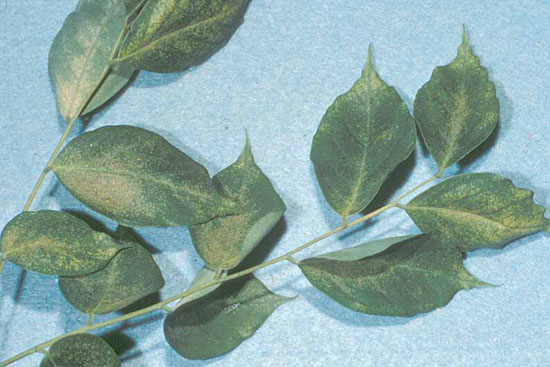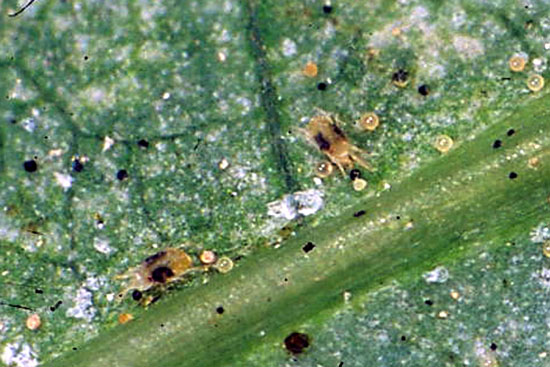Issue 9, June 18, 2012
Twospotted Spidermite
Twospotted spidermites are being seen on a variety of both deciduous and evergreen broadleaf plants. They and their relatives, including oak mite and honeylocust mite, thrive in the hot, dry conditions that we are experiencing in many areas of the state. In cooler, damper weather, fungi attack and kill them, keeping them under control.
Damage caused by twospotted spidermites initially appears as small, whitish areas on the upper sides of the leaves. These are caused by the spidermites sucking out the contents of several adjacent cells. This removes the chloroplasts which are green from chlorophyll, resulting in empty, whitish cells. These injured cells die and turn brown, causing the whitish areas to turn brown. From a distance, the damaged brown areas appear to be merged with the undamaged green areas of the leaves, giving a bronzish color to the leaves. Severely damaged leaves will curl and drop from the plant.

Twospotted spider mite damage on Kentucky coffeetree.
Spidermites are found primarily on the leaf undersides, although damage there is usually not apparent. The leaf undersite will appear dirty if there is a heavy mite infestation. Closer examination with a hand lens reveals that the dirt consists primarily of cast mite skins. The tiny, eight-legged mites tend to stay near the leaf veins. With adults being one-fiftieth of an inch long, they are too tiny to be seen by most people without magnification. Spidermites are clear with red eyes. Twospotted spidermites commonly have two large dark green areas that can be seen through the body wall, giving them their name. These dark areas are accumulations of body waste, so only older individuals have them.
Spherical, clear to yellow spidermite eggs are obvious on leaf undersides in heavy infestations. Eggs hatch into six-legged, clear larvae that molt to eight-legged protonymphs. These protonymphs molt to deutonymphs before molting to eight-legged adults. Fine, silk webbing may be seen on the leaf underside or between the petiole and stem, but this is usually blown away on outdoor trees and shrubs.
Scout for spidermites by holding a white sheet of paper below the branch, and then sharply striking the branch. This causes some of the mites to fall onto the paper where they can be seen. Spidermites will appear as greenish to grayish, slow-moving dots that streak green when smashed. Faster-moving red or clear mites that streak red when smashed are predatory mites that feed on the spidermites. If predatory mites are common, they are likely to control the spidermites without the need for miticides.

Close-up photo of twospotted spider mites.
Although another name for twospotted spidermite is red spider mite, they do not turn red unless they develop during cool weather. They are commonly red in Europe and in areas of the northeastern U.S. It is rare to see red twospotted spidermites in Illinois. I have seen red ones a couple of times when we had unseasonably cool weather in August. Generally, red mites on foliage in Illinois are predatory mites.
Spidermites are controlled with two or three miticide sprays applied at five to seven day intervals. Most miticides do not kill the eggs, so the repeated spray is meant to kill those that have hatched from the eggs before they become adults and lay more eggs. In hot weather, the mites grow up quickly, so a delay of only a day or two beyond a seven day spray interval is likely to require an additional spray application. Effective miticides include abamectin (Avid), acequinocyl (Shuttle), bifenthrin (Onyx, Talstar), etoxazole (TetraSan), hexythiazox (Hexygon), insecticidal soap, spiromesifen (Forbid), and summer spray oil. (Phil Nixon)
Author:
Phil Nixon